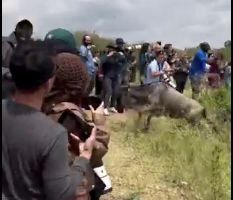

The Ministry of Tourism and Wildlife has outlined a raft of measures to uphold the standards of conduct to protect wildlife and visitors.
CS Rebecca Miano said her ministry has noted the widely circulated footage from the Maasai Mara showing visitors outside their tour vans in close proximity to wildlife during the ongoing wildebeest migration.
“It is imperative that all stakeholders—government, tour operators and visitors—uphold the highest standards of conduct to protect both wildlife and visitor safety,” she said in a statement.
On Tuesday, a video shared by wildlife advocates showed tourists ignore park regulations and blocked wildebeest river crossings during the annual Great Migration.
The video that has since gone viral showed visitors jumping out of safari vehicles and crowding the riverbank, disturbing the movement of wildlife.
“The county government of Narok, through the chief warden, has clarified that this occurred at the flooded Purungat Gate, where visitors had alighted while waiting for the water to subside," Miano said.
"While this context is important, the ministry remains deeply concerned by the images, given the global sensitivity surrounding conservation and the Maasai Mara’s critical role in Kenya’s international reputation.”
The CS said the country is a global leader in conservation and sustainable tourism and the Maasai Mara wildebeest migration is one of the world’s most extraordinary natural events and a Wonder of the World.
She said the government remains steadfast in its commitment to protecting our natural heritage, ensuring that conservation efforts are upheld as a cornerstone of our national identity and global reputation.
To curb the vice, Miano has since recommended a raft of measures.
The CS has called for strict enforcement of park rules adding that tour operators must ensure visitors remain in vehicles at all times, except in designated areas.
“Narok county, with support from the ministry and Kenya Wildlife Service, should increase ranger presence and strengthen enforcement, particularly at sensitive crossing points,” Miano said.
She warned that drivers, guides or companies permitting clients to disregard park regulations will face disciplinary or legal consequences.
The CS said visitor safety and wildlife protection are paramount and preventing dangerous interactions safeguards both lives and conservation integrity.
Miano said her ministry will collaborate with the county government of Narok to streamline regulations, harmonise visitor management, and run awareness campaigns for visitors and operators.
She said clearer signage and visitor education will be introduced at key gates and migration viewing points to prevent recurrence.
Miano said Kenya’s tourism future is anchored in our ability to protect visitors and wildlife.
“We must act decisively to preserve the Maasai Mara’s integrity, uphold visitor safety and demonstrate Kenya’s unwavering commitment to conservation. Together, we can ensure the Maasai Mara wildebeest migration remains not only one of the world’s greatest natural spectacles but also a symbol of Kenya’s leadership in conservation,” she said.
On Wednesday, Maasai Mara National Reserve chief warden Stephen Minus issued a statement condemning the incident.
Minus said the situation was immediately addressed by himself and rangers on site,who promptly instructed all visitors to return to their vehicles.
“This was done within a minute, which is why the circulating video is brief. No harm came to either guests or wildlife during this incident. Allegations that guests were asked for money in exchange for access remain unverified. If proven, such actions are a serious violation and will attract disciplinary action,” he said.
Minus said he had engaged the guides who were present and they committed to adhere to reserve rules and to prevent a repeat of such incidents.
When inside the park, human activity interferes with an animal’s behaviour.
To see an animal behave naturally, one must keep a good distance away.
Any closer than 25 metres (roughly five vehicle lengths) constitutes harassment of the animal and a breach of park rules, and one could face an on-the-spot fine.
When wild animals hear human voices they get afraid, causing them to move away or stop.
To watch animals continue with their normal hunting, feeding and nursing activities, tourists must lower their voice.
To get a better view, one can use a binoculars.
Guides who disobey the rules risk being fined or banned from the park.
No more than five vehicles are allowed around one wildlife sighting; when more than five the viewing time is reduced to 10 minutes.
Tourists can take turns to view the sighting, waiting at a distance of 100 metres.
Tourists are only allowed out of their vehicle at designated viewing points along the river and designated picnic sites.















